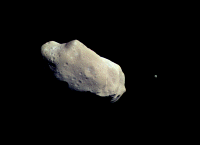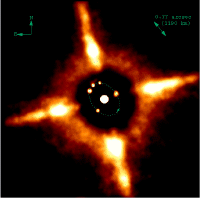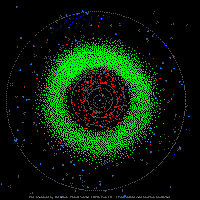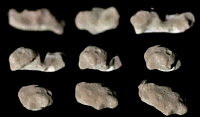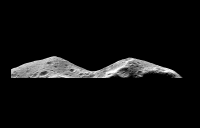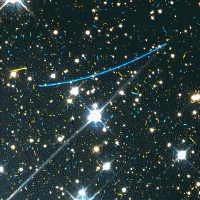Asteroids
Asteroids
 What are asteroids?
What are asteroids?
Figure 1. Asteroids come in many shapes and sizes. Here the large main belt asteroid Ida is shown with its much smaller moon Dactyl. This enhanced colour image was taken by the Galileo spacecraft on 28 August 1993.
Asteroids are often known as 'minor planets', since they are too irregular in size, too numerous and too small to be considered as proper planets. There are thought to be billions of these rocky objects orbiting the Sun.
Since they can only be seen as points of light in telescopes, British astronomer William Herschel coined the term `asteroid' - from a Greek word meaning `starlike' - to describe this new class of celestial objects. Earlier this century, astronomers coined a less poetic term for them - `vermin of the skies' - as they regularly appeared in photographs of distant galaxies and nebulas, spoiling the sensitive observations.
The largest of the asteroids, Ceres, was the first to be discovered. It was found by Giuseppi Piazzi from Palermo, Sicily on 1 January 1801. 1 Ceres is now known to have a diameter of about 940 km, only about one quarter the diameter of Earth's Moon. However, it contains more than one quarter of the total mass of all the asteroids. Another sixteen have diameters greater than 240 km. The smallest are like fragments of rock and boulders a few metres across. If all the asteroids were squashed into one object, they would still be smaller than the Moon.
 Asteroid moons
Asteroid moons
Figure 2. This computer processed image, taken in infrared light with the Canada-France-Hawaii Telescope on Mauna Kea, Hawaii, shows a small satellite orbiting asteroid 45 Eugenia. This is the first asteroid satellite ever seen from the Earth.
A few asteroids are known to have satellites which move around them in close orbits. The Galileo spacecraft discovered one of these moons when it flew past the asteroid (243) Ida on 28 August 1993. By chance, Galileo's pictures revealed a tiny object, now called Dactyl, which orbits within 100 km of its much larger neighbour.
In 1999, an international team of astronomers announced the discovery of a moon orbiting the large main belt asteroid 45 Eugenia. The pictures, taken with the Canada-France-Hawaii Telescope on Mauna Kea, Hawaii, were the first images of an asteroidal satellite taken from Earth. The observations could only be accomplished because of a new technique, called adaptive optics, that reduces the blurring caused by the Earth's atmosphere.
Previous attempts to photograph such satellites, using both ground-based telescopes and the Hubble Space Telescope, were unsuccessful.
A surprising result of this discovery is the very low density of Eugenia - only about 20% denser than water. Researchers estimate that the diameter of the satellite is about 13 km, compared with Eugenia's diameter of 215 km. The satellite has a circular orbit about 1 190 km away from Eugenia. Each orbit lasts about five days.
While awaiting assignment of a permanent name, the satellite has been given provisional designation, by the International Astronomical Union, of S/1998(45)1, i.e. the first satellite of asteroid (45) that was discovered during 1998.
Origin.
Meteorites that fall to Earth seem to be asteroid fragments which have broken off larger bodies during collisions. From studying these meteorites, scientists have learned that the asteroids are about 4.6 billion (thousand million) years old. They are, in fact, left overs from the formation of the Solar System, and carry a lot of information about conditions in the dust cloud that surrounded the Sun when the planets were born.
 Where are asteroids found?
Where are asteroids found?
Figure 3 .A map showing the distribution of all known asteroids between the orbits of Mercury and Jupiter. The orbits of the planets are shown in light blue. The asteroids are indicated by green circles. Objects which approach to within 1.3 AU (1.3 Earth distances) of the Sun are shown by red circles. Objects observed over several orbits are indicated by filled circles, objects seen at only one opposition are indicated by outline circles. The two "clouds" of objects 60° ahead and behind Jupiter along its orbit are the Jupiter Trojans, here coloured deep blue. Comets are shown as squares. (From the Minor Planet Centre)
More than 10 000 asteroids have so far been discovered and given permanent numbers, but there are thought to be billions more waiting to be found. Nearly all of these are contained within a doughnut-shaped region between the orbits of Mars and Jupiter. On the inner edge of this main belt, asteroids take about three years to orbit the Sun, while those near the outer limit of the main belt take twice as long.
The main belt is thought to exist because of the strong gravitational influence of the giant planet, Jupiter. At a time when `protoplanets' were colliding and growing, Jupiter prevented the formation of a planet.
Although there are billions of asteroids, the region they occupy is so vast that most of them are separated by thousands of kilometres of empty space. However, since they usually follow elliptical orbits, collisions are fairly common.
 Families and gaps
Families and gaps
Figure 4. There are millions of asteroids in the main asteroid belt between Mars and Jupiter and many thousands more in other regions of the Solar System. Ida, shown here from different viewpoints, is a fairly large member of the main asteroid belt.
Asteroids in the main belt are not evenly distributed. The gravitational influence of the planets, particularly giant Jupiter, causes them to collect in groups or `families'. One of the largest of these is the Flora family, which has about 400 known members.
Other parts of the main belt, known as Kirkwood gaps after their discoverer, are almost empty, due to so-called gravitational resonances. This means that regular gravitational interactions with Jupiter enable the planet to sweep the region clear of asteroids. One very apparent gap occurs at 2.5 AU (2 ½ times the Earth's distance from the Sun), where an asteroid completes three orbits for every one orbit by Jupiter. This is known as a 3:1 resonance.
Substantial numbers of asteroids also exist outside the main belt. Some of them are thought to be burnt-out comets that have lost much of their water ice after numerous close flybys of the Sun.
Others have been trapped by the gravity of the planets so that they follow unusual orbits. For example, over 200 asteroids share the orbit of Jupiter. These Trojan asteroids are trapped in two groups, one which follows 60° behind the planet and another which is 60° in front.
At least one small object, 3753 Cruithne, is known to travel in a strange horseshoe-shaped orbit around the Earth.
Many thousands of asteroids also inhabit the inner Solar System. The main groups are the Amors, which travel between the Earth and Mars; the Apollos, which cross Earth's orbit; and the Atens, which stay mainly inside Earth's orbit.
 Near-Earth asteroids
Near-Earth asteroids
When asteroids collide, some of them may be knocked out of the Main Belt and into the inner Solar System. Others may be disturbed by Jupiter's gravity. These objects cross the orbits of Mars and the Earth, occasionally striking the planets themselves.
Figure 5. Meteor Crater (also called the Barringer Crater) in Arizona is the best preserved and most famous impact crater on the Earth. The circular depression is about 1 200 m across, 183 m deep and is surrounded by a wall of debris 30-45 m high. It is thought to have been excavated by an iron-rich meteorite about 50 000 years ago.
Studies of these stray asteroids, or fragments of asteroids, are particularly important for the future of humanity, since many such objects have struck the Earth in the past, altering geological history and the evolution of life. Over 150 large impact craters have been identified on the Earth, but many more may lie hidden on the ocean floor. Many scientists believe that one 10 km-wide object caused the extinction of the dinosaurs when it struck the Gulf of Mexico 65 million years ago.
One of the most recent impact events occurred on 30 June 1908, when a small asteroid 100 m in diameter exploded over the remote region of Tunguska in Siberia, devastating more than half a million acres of forest.
Near misses are taking place all of the time. One close call occurred on 23 March 1989, when a 400 m wide asteroid came within 640 000 km of Earth. Surprised scientists estimated that Earth and the asteroid, which weighed 50 million tonnes and was travelling at 74 000 km/hour, had passed the same point in space just six hours apart.
Until recently, scientists thought the population of large near-Earth asteroids with diameters of more than one km was between 1 000 and 2 000. However, recent studies suggest that there are between 500 and 1 000 in this size category.
In the past, astronomers found asteroids by looking for streaks on photographic plates of the night sky. Today, most near-Earth asteroids are detected using robotic cameras such as a 1.2 m U.S. Air Force telescope on top of Mount Haleakala on Maui, Hawaii. Data gathered by the asteroid tracking system are processed by computer.
 What are asteroids like?
What are asteroids like?
Close-up photographs taken by spacecraft and ground-based radar studies of near-Earth objects show that nearly all asteroids are irregular in shape and heavily pockmarked by impact craters. Only a handful of the largest members, which are more than 300 km across, are spherical in shape.
Figure 6. Like Ida (shown here) all of the asteroids we have seen at close range are heavily cratered. This shows that they have suffered a very violent past. Most asteroids are probably fragments of much larger bodies which have been broken apart by major collisions over millions or billions of yearsi
Astronomers believe that they all asteroids are derived from around 640 `protoplanets' - each larger than Ceres. These were large enough to melt inside and allow heavy metals to sink to their centres. However, over billions of years, these protoplanets collided and broke up during numerous impacts. A large amount of material was lost, but the remnants form the main belt we see today.
Studies of light reflected from their surfaces suggests that there are several types of asteroids. More than three quarters of them are very dark - blacker than coal. These C-type asteroids seem to be rich in carbon, but may also contain large amounts of water. The large asteroid 140 Siwa, which is one of the targets of the Rosetta mission, belongs to this category.
S-type asteroids are a mixture of rock and metals such as nickel, iron and magnesium. This implies that they were once hot enough to melt - probably inside a larger parent asteroid or `protoplanet' which has since been destroyed. 4979 Otawara, a small asteroid to be visited by Rosetta, is thought to belong to this group.
Of the others, P- and D-types are reddish in colour, possibly due to `primitive' organic compounds, while M-types seem to be entirely made of metal.
Rock or rubble piles?
The presence of a moon or a spacecraft, such as Galileo, allows scientists to determine the mass of an asteroid because of the gravitational effects of the primary asteroid on the orbit of its small neighbour. If both the mass and the size of the asteroid are known, researchers can work out its density. The density then gives a clue to the asteroid's makeup - its composition and internal structure.
These studies have led to the surprising discovery that some asteroids are real lightweights - only about 200% denser than water. Until recently, most asteroids were thought to be composed primarily of rock, which has a density about three times greater than water.
It seems that these featherweight objects are either highly porous rubble-piles of rock, or mostly made of water ice. If the asteroids are rubble-piles, it tells us that they have undergone numerous, severe collisions over billions of years. If the objects are largely ice, covered with a dark-coating, then these objects may be remnants of burned-out comets.
 Asteroid numbers and names
Asteroid numbers and names
Figure 7. This Hubble Space Telescope picture shows an asteroid (blue trail) moving against the background stars. This asteroid has a diameter of about 2 km and was located 87 million miles from Earth and 156 million miles from the sun. Most asteroids are seen only as trails of light against the `fixed' background stars
The naming of an asteroid is the final step of a long process, which may take decades to complete. It starts when the asteroid is first observed for two consecutive nights by one observer. These results are then sent to the Minor Planet Centre of the International astronomical Union (IAU), which assigns a provisional designation. This is usually a serial number which identifies the observation group, e.g. 1992 KD.
The provisional designation includes the year of its discovery followed by two letters which give the order of its discovery during that year. Objects discovered between 1 and 15 January are designated, in order of their discovery, AA, AB, AC and so on. Those discovered between 16 and 31 January are given the letters BA, BB, BC etc. The final discoveries of the year, between 16 and 31 December, have designations in the series YA, YB, YC. (The letter J is not used.) So 1992 KD would be the fourth asteroid discovery in the last half of May 1992.
Asteroid moons are given different designations e.g. S/1998(45)1 is the first satellite of asteroid (45) to be discovered during 1998.
Once the provisional designation is given, a search for former observations of the asteroid is made. It is possible that different sightings of the same asteroid may have led to it being given many provisional designations over time. When there is enough information to calculate an accurate orbit, a permanent number is assigned to the asteroid.
The Minor Planet Centre in the United States currently has records on the orbits of some 57 000 asteroids and 1 050 comets. In 1999 alone, 25 000 new asteroids and 60 comets were discovered, but most of these have not been observed frequently enough for their orbits to be calculated with any accuracy. Only about 10 000 of the best observed objects, which have fairly well known orbits, have been given permanent numbers.
An asteroid with a permanent number will eventually be given a name. The discoverer, the astronomer who first provides enough observations to calculate the orbit with precision, has the privilege of choosing the name. Under this condition, the discoverer is not necessarily the first observer of the asteroid. The proposal is submitted to the Small Bodies Names Committee of the International Astronomical Union, which then makes it official if the proposal is considered to be acceptable.

